Nielsen: Political Media Plans Should Have A 10% Or Greater Allocation Of AM/FM Radio To Reach 45% Of Voters Not Reached By TV
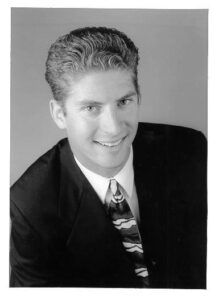
Tony Hereau, VP of Cross Platform Insights, Nielsen
Recently, Tony Hereau, Nielsen’s VP of Cross Platform Insights, made a presentation to the American Association of Political Consultants entitled The 10% Solution: Optimizing the Political Media Plan with Radio to Reach Swing Voters. His analysis finds that the addition of AM/FM radio to a political media plan can generate an extraordinary amount of incremental voter reach.
Here are Nielsen’s key findings:
45% of voters are zero/light TV viewers who are impossible to reach with TV ads
Nielsen finds there has been a sharp increase in voters who watch little or no TV. This presents a challenge to political media strategists who have historically placed the majority of their candidate budgets in TV.
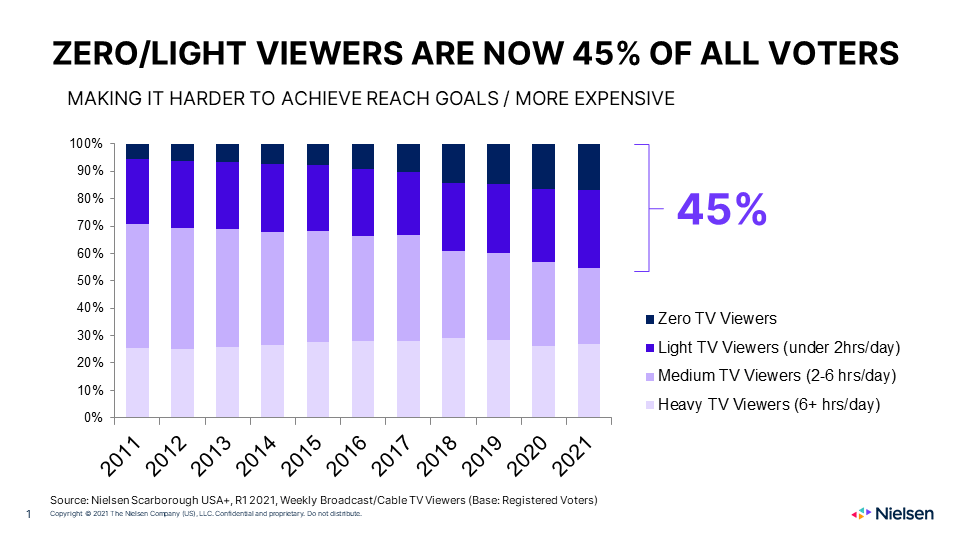
The combination of connected TV and AM/FM radio can reach voters who are zero/light TV viewers
AM/FM radio reaches 82% of zero/light TV voters. Connected TV reaches 62% of zero/light TV voters. Combined, CTV and AM/FM radio can significantly supplement the political media plan.
55% of voters who are heavy/medium TV viewers are well exposed to TV ads. 37% of the zero/light TV voters are reached by AM/FM radio. The remaining 8% are exposed by CTV.
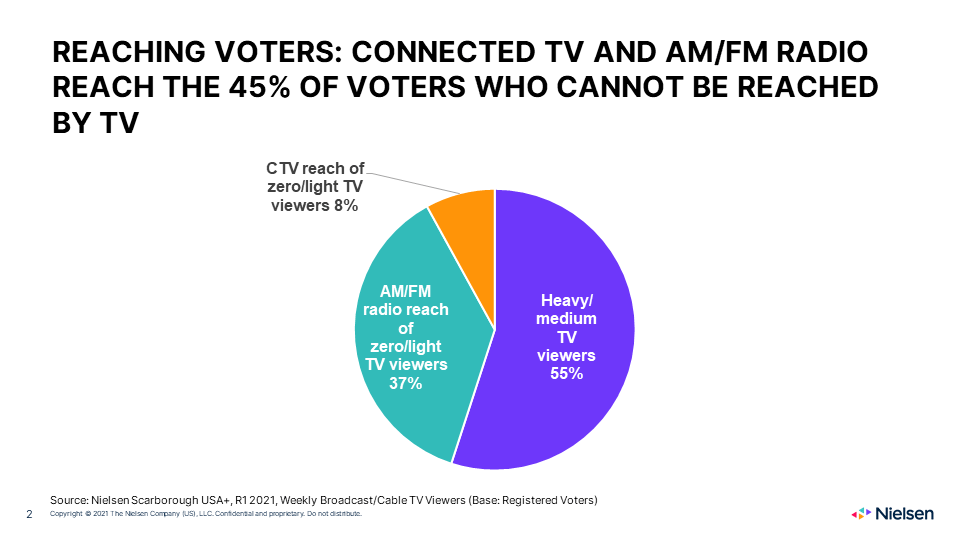
Zero/light TV voters reached by AM/FM radio are younger, upscale, and more likely to have kids
The 82% of zero/light TV voters reached by AM/FM radio have a distinct profile. Compared to total U.S. registered voters, voters who can only be reached by AM/FM radio are:
- Younger, with a median age of 40 versus 51 for all voters
- Have a greater presence of children
- More likely to have a college degree and a white-collar job
- Have a greater household income
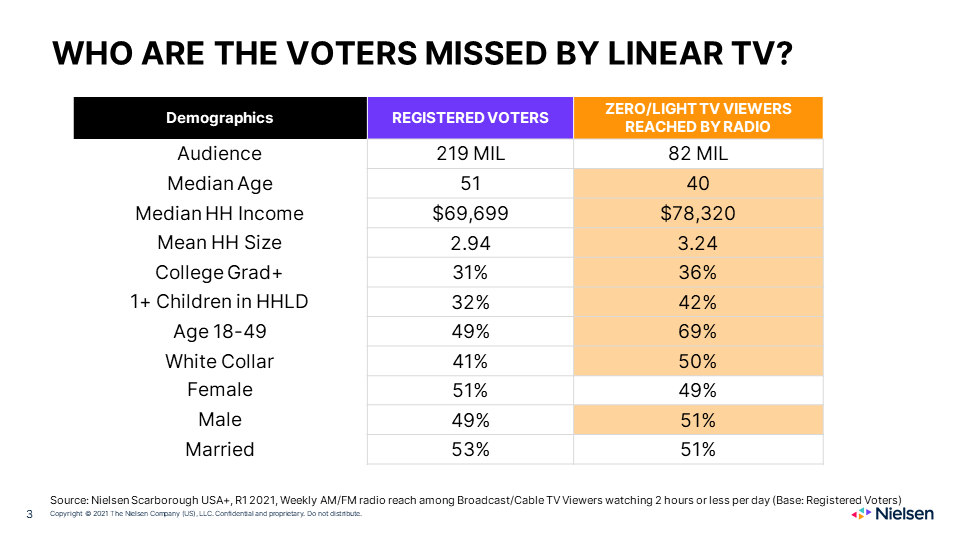
AM/FM radio is a rich source of swing voters
Nielsen finds that large portions of AM/FM radio programming format audiences are swing voters. Nielsen defines swing voters as moderate Republicans and Democrats, Independents, and unaffiliated voters. Swing voters can be found all the across the dial, not just on News/Talk stations.
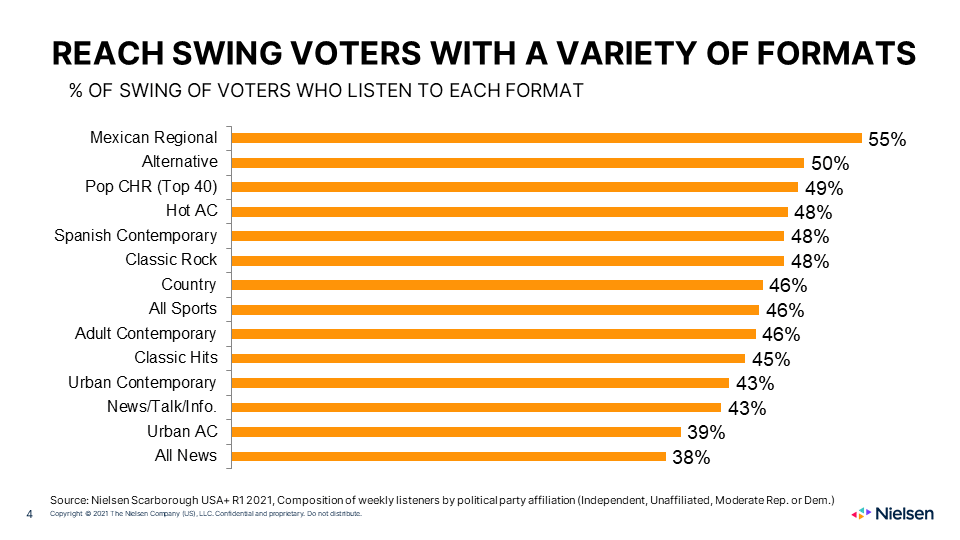
40% to 50% of AM/FM radio programming format audiences are swing voters, according to Nielsen. These findings contradict many stereotypes such as Spanish radio listeners always being Democrats, Country listeners always being Republicans, and News/Talk listeners always leaning conservative.
AM/FM radio offers candidates an uncluttered environment to achieve an unfair share of voice
Nielsen analyzed political ad counts on TV and AM/FM radio in the run up to 2020 Georgia Senatorial races. In the Atlanta DMA, one-third of all ads on TV were political while only 12% of AM/FM radio ads were political.
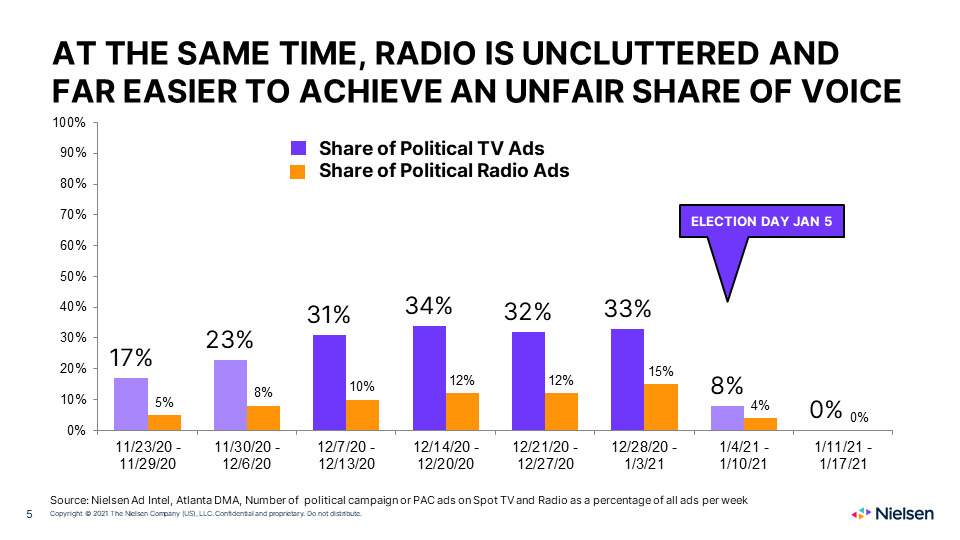
A 10% allocation to AM/FM radio boosts voter reach by +8% with no increase in budget
Given that political races are being decided by such slim margins, ad campaigns must be optimized for the largest possible reach. Using their media optimization platform, Nielsen Media Local Impact, Nielsen compared two media plans.
The first consisted of a standard $250,000 political media plan with the following allocations:
- 50% broadcast TV
- 20% cable TV
- 15% OTT/CTV
- 15% digital
The second plan, optimized for greater voter reach with the same budget, had the following allocations:
- 45% broadcast TV
- 15% cable TV
- 15% OTT/CTV
- 15% digital
- 10% AM/FM radio
Here is the comparison of the audience of the standard plan versus the optimized plan. Introducing a 10% allocation for AM/FM radio causes reach to grow by 235,000 voters, an +8% increase. Impressions were up +7% while frequency was stable and CPM was more efficient.
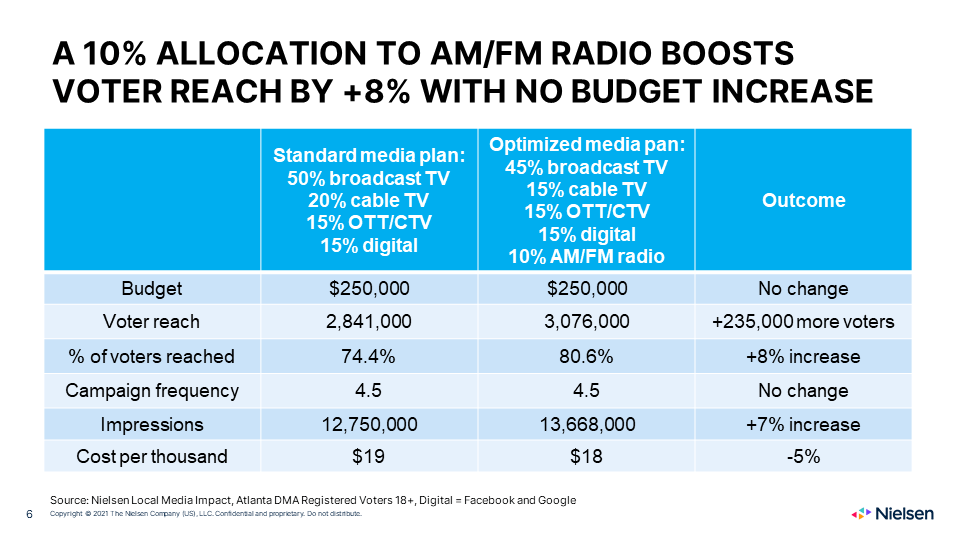
AM/FM radio is the voter reach accelerator
The benefit of introducing AM/FM radio into the plan comes with reach rather than frequency. Putting AM/FM radio into the plan means the buy will reach more voters, rather than hitting the same voters more frequently.
One of the legitimate concerns about connected TV is excessive frequency. A recent Nielsen analysis found that adding 50 CTV GRPs to an existing TV buy only lifts reach by +8%. The same GRP addition to AM/FM radio resulted in a +24% lift in incremental reach.
The vast majority of weight added to AM/FM radio results in reach lift rather than frequency increases. AM/FM radio is a rich source of voter reach.
AM/FM radio advertising was the untold secret ingredient to Glenn Youngkin’s Virginia gubernatorial victory
An analysis by the Center for Campaign Innovation concludes, “Radio ads by Virginia Republican gubernatorial nominee Glenn Youngkin … played a disproportionate role in helping to boost the candidate to narrow victory in November over former Democratic Gov. Terry McAuliffe.” With outcomes being decided by the slimmest of margins, introducing AM/FM radio in the media plan with at least a 10% allocation generates substantial lift in voter reach among those not exposed on TV.
Key findings from Nielsen’s report:
- Zero/light TV viewers have grown significantly, representing 45% of voters
- The combination of connected TV and AM/FM radio can reach zero/light TV viewers
- Zero/light TV voters reached by AM/FM radio are younger, upscale, and more likely to have kids
- AM/FM radio offers candidates an uncluttered environment to achieve an unfair share of voice
- 40% to 50% of AM/FM radio programming format audiences are swing voters
- A 10% allocation to AM/FM radio boosts voter reach by +8% with no increase in budget
- AM/FM radio advertising was the untold secret ingredient to Glenn Youngkin’s Virginia gubernatorial victory
Pierre Bouvard is Chief Insights Officer at Cumulus Media | Westwood One and President of the Cumulus Media | Westwood One Audio Active Group®.
Contact the Insights team at CorpMarketing@westwoodone.com.